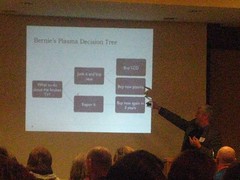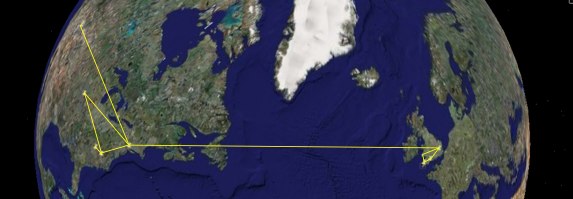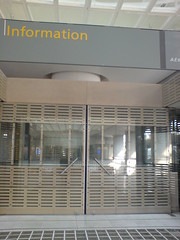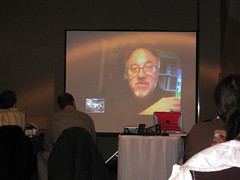 I’m sitting in the back of the room for the keynote. Bernie Dodge, who is apparently a regular at the eMINTS Winter Conference, will take us all on a journey, starting in about thirty minutes. My workshop went well yesterday, though the backchannel was a lot more interesting. I transfered it over to a wiki for participants view again and even continue to flesh out.
I’m sitting in the back of the room for the keynote. Bernie Dodge, who is apparently a regular at the eMINTS Winter Conference, will take us all on a journey, starting in about thirty minutes. My workshop went well yesterday, though the backchannel was a lot more interesting. I transfered it over to a wiki for participants view again and even continue to flesh out.
After Bernie’s keynote, I’ll do a presentation on video games and then one on Web 2.0, although the term doesn’t show up anywhere in the title or the description. I’m planning to concentrate on what we can do with community constructed content that is new.
This appears to be one of the small but truly rich conferences. A lot of the folks here know each other. There are eMINTS trainers, who all work together. I think they might be entering the Twitterverse very soon. Then there are eMINTS teachers, who are also forming a community. I haven’t looked at the program yet, but the young man next to me is signed up for digital photography, working magic on the new web, teaching with Google Earth, and what appears to be a share a site session.
Bernies standing against the wall, about a hundred feet away, arms folded, observing his domain. The opening slide is up, “KIDS AS DECIDERS.” Hmmm!
The keynote has begun, and Bernie’s talking about Twitter, the evolution of his conversion. He’s showing his aggregator, and how he’s set up a Twitter search feed so that if anyone uses the word webquest in a Twitter post, it comes to him. (How does he do that?) He says that personal networks are about listening, knowing how to put your ear to the network.
So how do we teach things that we know students should be learning, such as decision making. Bernie recalls Micheangelo, who said that the scupture is already in the stone. His job is to uncover it. Dodge suggests that finding opportunities to help students learn decision making are inside the curriculum we’re teaching today. It’s a matter of uncovering them. He suggests that we look for or create disequilibrium, so something has to happen, and leave it to the kids to make it happen. There are three ways to do this.
- Identify (or makeup) an oportunity for action that requires choosing from among alternatives.
- Identify a real problem over which there is strong disagreement and decided on what to recommend
- Change the situation to create new problems that someone needs to decide how to respond to.
He’s suggested a Webquest that he recently found on the Net, and asked the audience how they might change the situation (1,2,or3) of the activity to provoke decision making.

 I’m sitting in a warm hotel room in Columbia, Missouri, where the
I’m sitting in a warm hotel room in Columbia, Missouri, where the  Right now, I’m there (MCNC). I posed a question on Twitter yesterday, asking folks what they could/would do with super high-speed Internet. I may post the responses below. One of the things that I’m hearing, at this point, is the Internet2 will do a better job of doing what Internet(1) should be doing. It will provide more reliable service of information and communication.
Right now, I’m there (MCNC). I posed a question on Twitter yesterday, asking folks what they could/would do with super high-speed Internet. I may post the responses below. One of the things that I’m hearing, at this point, is the Internet2 will do a better job of doing what Internet(1) should be doing. It will provide more reliable service of information and communication.
 The article seems to make two cases. One is that we do not have a clear and authoritative definition of fair use for education and libraries — and second, that our current notions of fair use are excessively conservative, and that what and how students learn in our schools is suffering as a result.
The article seems to make two cases. One is that we do not have a clear and authoritative definition of fair use for education and libraries — and second, that our current notions of fair use are excessively conservative, and that what and how students learn in our schools is suffering as a result.

 I guess I was missing the conference I was supposed to be working yesterday, because I and dozens of other folks were watching
I guess I was missing the conference I was supposed to be working yesterday, because I and dozens of other folks were watching  Will’s presentation was cut off by network difficulties, but the parts I saw were about user-generated content, as it relates to video games. He showed a graph showing the number of people involved in the development of Robb (1984), SimCity (1989), SimCity2000 (1994), The Sims (2000), The Sims (2004). The portion of the workers who are involved in content development, as opposed to programmers, has been increasing. He says that it the current rate, by 2050, it will take 2,500,000 people to produce a single game and $500,000,000,000. That won’t work, so it’s why he’s looking at game design that depends on users to generate the content of the game.
Will’s presentation was cut off by network difficulties, but the parts I saw were about user-generated content, as it relates to video games. He showed a graph showing the number of people involved in the development of Robb (1984), SimCity (1989), SimCity2000 (1994), The Sims (2000), The Sims (2004). The portion of the workers who are involved in content development, as opposed to programmers, has been increasing. He says that it the current rate, by 2050, it will take 2,500,000 people to produce a single game and $500,000,000,000. That won’t work, so it’s why he’s looking at game design that depends on users to generate the content of the game.

 This little tidbit was shared by
This little tidbit was shared by